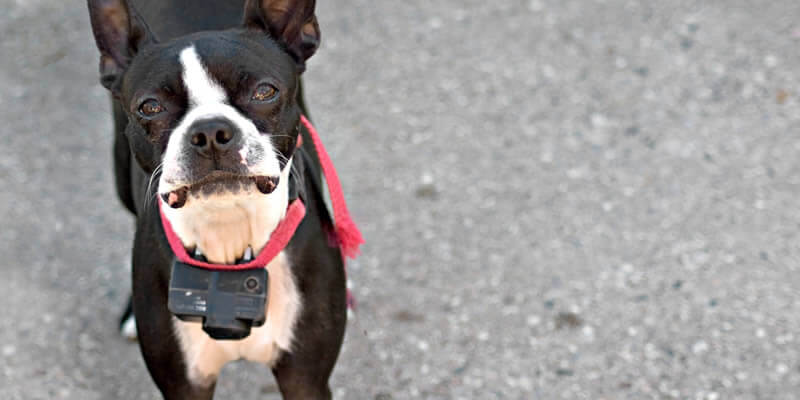Wireless or Invisible Pet Fencing Installed Cost
The average cost to have a wireless pet fence installed around your yard is $2.50 per foot. A fence contractor will come in and mark the area first, then have it checked for underground utilities before doing any of the installation work.
The contractor will usually supply the machinery, tools and labor to install the underground wire, all connectors, collars for your pets, the indoor power system and all needed attachments. Most often, they also leave the flags in place so you can use them during the training process after the installation is complete.
Average Costs
Overview of Invisible Dog Fences
An invisible dog fence keeps your yard open and uncluttered while preventing your pet from roaming loose where dangers lurk. Invisible fence cost is significantly less than the cost of other types of fencing too, and your options include a buried wired fence, and wireless dog fence systems that work based on a perimeter versus wire being buried in your yard.
This page of Costimates provides an overview of your options for an electric fence for dogs. The cost range for each type of system, buried wire or wireless, and its accessories such as additional collars is included. Our goal is to make it easy to compare invisible dog fence cost as you decide which system is right for you and your pet.
Invisible Fence Types
The two types of pet containment systems are wired and wireless invisible fences. The pricing is itemized below to give you a very clear estimate of what your cost will be for the system you choose and the number of dogs it will serve.
Wired Invisible Fence
There are two options for an underground invisible fence, sometimes called a buried wire fence or an in ground fence. The DIY option is a kit with everything included. Most kits have 500 feet of wire, sufficient to create a square of 15,625 square feet or about .36 acres. Kits with 1,000 feet of wire are available too for up to 62,500 square feet of containment, or 1.45 acres.
The second option is to hire a company that installs invisible fences customized to your yard. Invisible fence prices for DIY and professionally installed systems are found below.
The advantage of a wired dog fence is that you can determine the exact shape and location of the boundary. The disadvantages are that installing wire beneath driveways and sidewalks takes extra time and cost. The process is also difficult where lateral tree roots are near the surface. Should the wire break, a rare occurrence, finding the break can be a challenge.
Underground fence components and how they function:
- A wire/cable is installed a few inches below ground around the perimeter you choose for your pets
- A transmitter generates and sends a digital signal through the cable when the system is on
- Your dog or cat wears a receiver collar that can pick up the digital signal as it nears the cable
- Some collars give a warning tone or vibration as the dog or cat gets near the perimeter, and if it continues, a mild shock, called a “static correction” or “corrective stimulation” by various manufacturers, is given
- The shock level can be adjusted, lower for small dogs and higher for large and/or stubborn dogs
- Many systems include small flags, like utility line marking flags, that can be used to mark the perimeter to give your pet a visual reminder during the training period
- Accessories include additional wire and collars; for large areas, a second transmitter and additional training flags might be required
Wireless Dog Fences
These systems function much the same as a wired pet containment fence, but the boundary produced is circular. Most have a transmission radius of about 100 feet in all directions, so produce a circle about 200 feet across. This equals about 31,000 square feet or .72 acres. The disadvantages of a circle are that the perimeter rounds off corners of a rectangular yard, it can be more difficult for the dog or cat to learn its boundaries and you can’t create a specific boundary around a pool, the garden or other feature of the landscape. The advantages are lower total invisible fence cost due to DIY installation and that driveways and walkways don’t pose installation problems. Wireless fence cost is itemized below including the cost of kits and accessories.
Wireless fence components and how they function:
- A transmitter is plugged into a central location such as a garage
- The transmitter is digitally set to the radius you choose
- Your pet wears a collar, and the system works the same as a wired pet boundary system. Most accessory options are the same, though just a single transmitter can be used in wireless fence systems.
Invisible Fence Price Factors
If you buy a DIY wired or wireless kit, your costs will vary depending on the kit’s quality and the size of the area it serves.
Here are additional cost factors to consider:
- Tools used for DIY trenching – A shovel is cheap, but the work is harder than if you rent a trencher.
- The length of your professionally installed fence—Cost is determined in part by the amount of wire installed and whether an additional transmitter is required
- The complexity of a professionally installed fence—Jobs with straight lines in open ground are the most affordable. Non-rectangular installations and those with obstacles such as driveways, sidewalks and large tree root systems cause the price to rise.
- The number of collars required – Most kits contain one receiver collar.
- Additional training flags—Kits with flags usually contain one flag for each 10-20 feet of wire.
Cost of Fence Wire, Controller, Accessories and Supplies
How much does invisible fence cost? Let’s itemize your potential costs based on the type of system you choose. Prices for sets and accessories vary significantly based on the quality of the components and the gauge of the wire included.
- $150-$325 | Wired fence kit with 500-1,000 feet of wire and one or two collars
- $150-$300 | Wireless fence kit with one or two collars
- $70-$160 | Additional collar
- $16-$40 | Spool with 500’ of wire
- $10-$13 | Set of 50 additional flags
- $8-$12 | Replacement receiver straps
- $14-$24 | Replacement rechargeable receiver batteries
- $65-$100 | Trencher rental based on half-day and full-day rental
Professionals use top-quality equipment with heavy-gauge wire to limit the risk of having to return to repair or replace anything. Invisible fence contractors charge you for the kit, extra accessories and the time estimated to install the system. The rate for installation ranges from $0.35 to $1.25 per linear foot of wire installed underground, the cost varying based on the shape of the perimeter and the types of obstacles encountered. Here are examples of installed invisible fence cost using professional-quality equipment:
- $475 – $875 | System with 500 feet of wire (about .36 acres)
- $600 – $1,250 | System with 850 feet of wire (1 acre)
- $635 – $1,475 | System with 1,000 feet of wire (about 1.45 acres)
Estimate larger areas based on about $300 for the kit (transmitter with power cord, wire, one collar) with installation starting at $0.35/linear foot for rectangular perimeters in soft soils with no obstacles. The cost can be as high as $1.25/linear foot for installation with more than 4 corners or curved lines in dry clay or gravel and obstacles to work around.
Pro installation usually includes brief tutorials on how to use the system and how to train your dog or cat. How-to training videos can be viewed online too.
Invisible Fence Cost per Foot or Acre
The costs below represent the linear length in feet, measured around the perimeter of land area.
| Area Size (Linear feet) | Wireless Fence Cost | Estimated Installed Cost |
|---|---|---|
| 1 Acre (Approx 850 feet) | $200 – $325 | $1,250 |
| 2 Acres (Approx 1,700 feet) | $300 – $425 | $2,600 |
| 3 Acres (Approx 2,550 feet) | $400 – $525 | $3,980 |
| 4 Acres (Approx 3,400 feet) | $500- $625 | $5,550 |
| 5 Acres (Approx 4,250 feet) | $650 – $775 | $9,150 |
| 10 Acres (Approx 8500 feet) | $800 – $925 | $16,650 |
Permits, Inspection and Installation Time
- $0 | No permit is required for an invisible dog fence
- $0-$75 | The cost to mark underground utilities. Most underground fence wire isn’t installed deep enough to hit utilities. If you have concerns, call your utility company or 811 (in most areas) to determine whether utilities need to be marked, so that in-ground fence installation avoids them. The service is free in most areas.
Invisible Fence Install Time Schedule
Here’s a look at the timeframe for having an invisible dog fence installed:
- 1 day: Most invisible fence installations covering up to 1.5 acres plus owner/pet tutorials
- 2 days: Complex smaller jobs and larger jobs covering up to 5 acres
- 3 days or more: Large jobs with complex installation requirements
Related Projects
We’ve found the projects listed below to be commonly related to invisible fencing, fences in general, or other home improvement or repairs closely related to this type.
Are You a Pro Invisible Fence Installer?
If so, head over to our Costimates Pro’s page, and help us make this page better and more accurate for both our visitors and your future customers.
DIY or Hire a Pro?
I’ve installed both buried wire and wireless dog fence systems over the years. In our current home we have a split rail fence, due to our location. Our wireless system worked OK for a single 20 pound dog, but when we got another, it couldn’t seem to handle it well. It may have been the age of the system as well. The wired, underground fence we had in another home was perfect and we rarely to never had any issues. Read here for Pros and Cons of each type.
- Wireless is very easy to install. Plug it in, setup your perimeter and train your pet.
- Buried wire is simple to install, but you’ll want to get a small trencher to make the project go smooth and quickly. It’s not required and you can dig by hand as well, but it takes quite a bit longer.
- Basic wall mounting experience is needed to mount either system to a wall, and for the wired systems, you should have basic electric system understanding.
- Training your pet is the most important step to avoid injuries or unnecessary shocks by either of the systems.
For the DIY’ers out there, Home Depot rents a tool to help wiht installation of low voltage wire, like underground pet fence wire.


 Steve Hansen, that's me, the Senior Editor of Costimates. (
Steve Hansen, that's me, the Senior Editor of Costimates. (